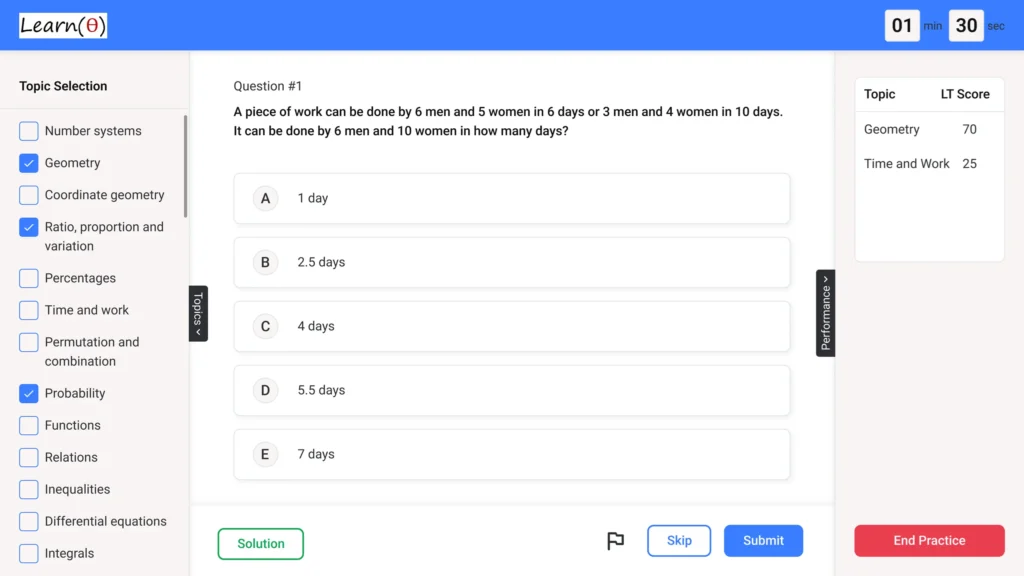Class 9 Maths: Ch 7 – Triangles – Extra Questions with Answers
Q. 1 If AD is the median of $\triangle ABC$ and P is a point on AC such that $ar(\triangle ADP) : ar(\triangle ABD) = 2:5$, then $ar(\triangle PDC) : ar(\triangle ABC)$ is?
Check Solution
Ans: B
Solution:
Since AD is a median, $ar(\triangle ABD) = ar(\triangle ADC)$.
Given $ar(\triangle ADP) : ar(\triangle ABD) = 2:5$, we have $ar(\triangle ADP) = \frac{2}{5} ar(\triangle ABD)$.
Then, $ar(\triangle PDC) = ar(\triangle ADC) – ar(\triangle ADP) = ar(\triangle ABD) – \frac{2}{5} ar(\triangle ABD) = \frac{3}{5} ar(\triangle ABD)$.
Since $ar(\triangle ABD) = \frac{1}{2} ar(\triangle ABC)$, we have $ar(\triangle PDC) = \frac{3}{5} \cdot \frac{1}{2} ar(\triangle ABC) = \frac{3}{10} ar(\triangle ABC)$.
Therefore, $ar(\triangle PDC) : ar(\triangle ABC) = \frac{3}{10} : 1$.
Answer: 3/10
Q. 2 An exterior angle of a triangle is $120^\circ$, and one of the interior opposite angles is $50^\circ$. Then the other interior angle is $K \times 10^\circ$. Find K.
Check Solution
Ans: D
Solution: The exterior angle is equal to the sum of the two interior opposite angles. Therefore, the other interior angle is $120^\circ – 50^\circ = 70^\circ$. $70^\circ = K \times 10^\circ$, so $K=7$.
Answer: 7
Q. 3 In an isosceles triangle, the two equal sides are 17 cm each. The altitude drawn to the base is 8 cm long. What is the length of the base of the triangle?
Check Solution
Ans: C
Solution: The altitude bisects the base, forming two right triangles. Using the Pythagorean theorem, half the base = √(17² – 8²) = √(289 – 64) = √225 = 15 cm. Therefore, the base = 2 * 15 = 30 cm.
Answer: 30 cm
Q. 4 The sum of two angles of a triangle is $122^\circ$, and their difference is $30^\circ$. Find the measure of each angle of the triangle.
Check Solution
Ans: B
Solution:
Let the two angles be $x$ and $y$. We have $x+y=122$ and $x-y=30$.
Adding the two equations, $2x=152$, so $x=76$.
Then $y=122-76=46$.
The third angle is $180-122=58$.
Answer: $76^\circ, 46^\circ, 58^\circ$
Q. 5 Find the value of $y$ in the following: $y^2 + 8^2 = 10^2$
Check Solution
Ans: A
Solution:
$y^2 + 64 = 100$
$y^2 = 100 – 64$
$y^2 = 36$
$y = \sqrt{36}$
$y = 6$
Answer: 6
Q. 6 A rectangular garden has a diagonal of 17 meters and one side of 8 meters. What is the perimeter of the garden?
Check Solution
Ans: B
Solution:
Use the Pythagorean theorem to find the other side: a^2 + b^2 = c^2. 8^2 + b^2 = 17^2, 64 + b^2 = 289, b^2 = 225, b = 15. Perimeter = 2(length + width) = 2(8 + 15) = 2(23) = 46.
Answer: 46 meters
Q. 7 The angles of a triangle are in the ratio 3 : 5 : 4. The largest angle of the triangle is ______ degrees.
Check Solution
Ans: C
Solution: The sum of the angles in a triangle is 180 degrees. Let the angles be 3x, 5x, and 4x.
3x + 5x + 4x = 180
12x = 180
x = 15
The angles are 3(15) = 45, 5(15) = 75, and 4(15) = 60. The largest angle is 75 degrees.
Answer: 75
Q. 8 In $\triangle ABC$, if $\angle A + \angle B = 130^\circ$ and $\angle A + \angle C = 110^\circ$, find $\angle A$, $\angle B$ and $\angle C$.
Check Solution
Ans: D
Solution:
We know that $\angle A + \angle B + \angle C = 180^\circ$.
From the given information, $\angle A + \angle B = 130^\circ$. Substituting this into the sum of angles of a triangle, we have $130^\circ + \angle C = 180^\circ$, which means $\angle C = 180^\circ – 130^\circ = 50^\circ$.
We are also given $\angle A + \angle C = 110^\circ$. Since we found that $\angle C = 50^\circ$, we can substitute this into the equation, so $\angle A + 50^\circ = 110^\circ$. This gives us $\angle A = 110^\circ – 50^\circ = 60^\circ$.
Now, we can find $\angle B$. We know that $\angle A + \angle B = 130^\circ$, so $60^\circ + \angle B = 130^\circ$. This implies $\angle B = 130^\circ – 60^\circ = 70^\circ$.
Answer: $\angle A = 60^\circ$, $\angle B = 70^\circ$, $\angle C = 50^\circ$
Q. 9 In a $\Delta ABC$, if $\angle A – \angle B = 30^\circ$ and $\angle B – \angle C = 15^\circ$, then $\angle B = ?$
Check Solution
Ans: D
Solution:
Let $\angle A = x$, $\angle B = y$, $\angle C = z$.
We have $x – y = 30^\circ$ and $y – z = 15^\circ$.
Also, $x + y + z = 180^\circ$.
From $x – y = 30^\circ$, we have $x = y + 30^\circ$.
From $y – z = 15^\circ$, we have $z = y – 15^\circ$.
Substitute $x$ and $z$ in $x + y + z = 180^\circ$:
$(y + 30^\circ) + y + (y – 15^\circ) = 180^\circ$
$3y + 15^\circ = 180^\circ$
$3y = 165^\circ$
$y = 55^\circ$
Therefore, $\angle B = 55^\circ$.
Answer: $55^\circ$
Q. 10 In triangle ABC, the angle bisector of angle A intersects BC at point D. If AD is perpendicular to BC, prove that triangle ABC is isosceles.
Check Solution
Ans: D
Solution:
Since AD is the angle bisector of angle A and AD is perpendicular to BC, we have two congruent triangles, ABD and ACD (ASA congruence: angle BAD = angle CAD, AD=AD, angle ADB = angle ADC = 90 degrees). Therefore, AB = AC.
Answer: Triangle ABC is isosceles.
Q. 11 The angles of a triangle are in the ratio $1:2:3$. The smallest angle of the triangle is
Check Solution
Ans: B
Solution: Let the angles be $x, 2x, 3x$. The sum of angles in a triangle is $180^\circ$.
Therefore, $x+2x+3x=180^\circ$, which means $6x=180^\circ$.
So, $x=30^\circ$. The smallest angle is $x$.
Answer: 30
Next Topic: Quadrilaterals
Practice Extra Questions for Class 9 Maths
Build Strong Concepts for Maths & Science – with LearnTheta’s AI-Practice!

✅ All Topics at One Place

🤖 Adaptive Question Practice

📊 Progress and Insights